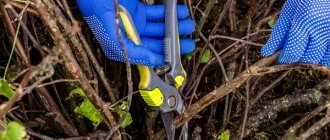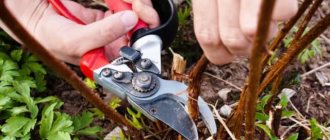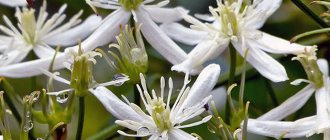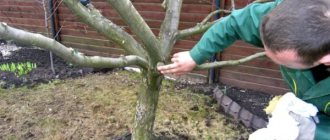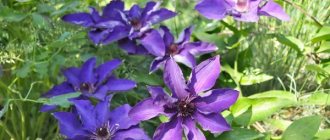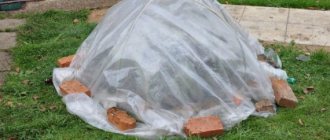Description
Blueberry is a small shrub with leaves that fall in winter and belongs to the Heather family. People often call it water drinker, blueberry or blue grape. The plant prefers the cold and temperate climate of the northern hemisphere. It is usually found in marshy soils, uplands, or coniferous forests.
The maximum height of blueberry bushes is 1 m. Its branches are straight with brown or dark gray bark, covered with small hard leaves planted on short petioles. The upper side of the leaves is covered with a waxy coating and has a bluish-green color, the lower side is lighter. During flowering, the shrub is covered with small drooping five-toothed white or pinkish flowers. Then, in their place, small blue berries of an oblong shape, covered with a bluish coating, are formed.
In the Russian climate, ordinary blueberries or some varieties of garden varieties with early ripening are successfully grown. In southern regions with a favorable climate, American highbush blueberries can be grown. It is distinguished by large berries weighing 10-20 g. The yield is up to 7 kg if grown correctly.
General care recommendations
Caring for blueberries in the fall is necessary for good growth of the bush.
This is impossible without proper watering. At the beginning of July, the bush is moistened abundantly, since this is when the formation of fruit buds for the next growing season occurs. With the onset of autumn, the intensity of watering is reduced. If the weather is rainy, then irrigation is stopped completely. Important! One of the main stages of autumn care is mulching.
This procedure promotes better moisture retention. Suitable materials for mulch are rotted sawdust, bark or spruce branches of coniferous plants. Blueberries are fed exclusively with mineral complexes, since they do not tolerate organic matter. In summer, fertilizers are applied twice. In the fall, it is enough to add potassium and superphosphate to the soil once. Mineral deficiency causes leaves to wilt and dry out.
In the fall, sanitary pruning of bushes is performed. To do this, remove broken, dried or diseased branches. Those parts of the plant that have been infected with parasites must also be pruned.
In areas with harsh, frosty winters, blueberries must be covered. To do this, the shoots are attached to ropes stretched between the supports. They are covered with spruce branches on top. If temperatures in the region do not fall below -25 degrees in winter, it is not necessary to close blueberries for the winter.
Features of caring for blueberries
Care includes regular watering, fertilizing and pruning of bushes. Soil pH needs to be controlled. Blueberries are a self-fertile plant. For pollination, it is necessary to plant varieties with approximately the same flowering period in one area. Productivity will increase with the presence of pollinating insects. To protect the crop during the fruiting period, it is necessary to install bird repellers on the site.
Make sure there are no weeds in the beds. Mulching will help avoid the problem. The mulch layer needs to be updated periodically. The roots of the plant are shallow, so loosening and inter-row cultivation must be done carefully. Pests that can grow on blueberries include leaf rollers, aphids, beetle larvae and caterpillars. To combat insects, the drugs Calypso and Aktara are used.
Autumn pruning of blueberries
This event is one of the mandatory steps to obtain a good harvest in the next growing season. Ignoring autumn pruning leads to the rapid degeneration of a cultivated berry into a wild one. In spring, a lot of young shoots grow, which take all the strength of the plant for its development. Due to the thickening of the bush, the branches grow weak and thin, and the taste of the berries deteriorates. The dense crown attracts many parasites and becomes a breeding ground for diseases.
Weak, diseased or broken branches need to be cut out throughout the year, and not just with the onset of autumn. In spring it is convenient to cut off frozen shoots. In the summer months, the shoots that thicken the bush are removed. In autumn, golberry is pruned for sanitary purposes.
Formative pruning
Pruning of branches to shape the bush is done after the sap flow has completely stopped. From mid-October, the branches that thicken the bush are removed, covering the cut areas with garden pitch. This measure protects the plant from infection. Pruning is completed before the end of November so that the bush is not damaged by frost.
Important!
Removal of young growth begins in the first year of development. The root shoots that grow during this period take away the plant’s strength and the shrub grows weak.
Blueberries planted in the spring are cut off in the fall, all the branches and root growth that has grown over the summer are cut down. After pruning, what remains is a seedling of erect columns 30 to 40 cm long without lateral branches.
You may be interested in:
Proper care of raspberries in the fall and their preparation for winter. Yield indicators when growing raspberries will directly depend on correctly carried out measures after...Read more...
Pruning an adult plant is done as follows:
- horizontal shoots are cut to a strong vertically directed branch;
- shoots directed deep into the bush or downwards;
- the tops of branches damaged by cold or insects;
- branches shorter than 30 cm.
Anti-aging pruning
In adult bushes, shoots are cut off for the purpose of rejuvenation. Then they cut down all the old, non-fruit-bearing branches, which take away useful elements for their growth. After this procedure, the young branches grow quickly in the spring and produce a good harvest.
When and what to feed blueberries in the fall
The purpose of autumn feeding is to help the shrub lay new flower buds for next year, as well as prepare the plant for winter (strengthen its immunity and improve winter hardiness).
By the way! The site has a detailed article on how to properly feed garden blueberries in spring, summer and autumn .
When to Apply Fertilizer
The last (autumn) feeding of blueberries is done after fruiting and berry picking, i.e. in the fall.
What to feed
phosphorus-potassium fertilizers must be applied to all perennial plants (including blueberries) .
By the way! The site has separate material on how and what to feed blueberries throughout the season (spring, summer and autumn) .
Thus, phosphorus is necessary for the plant to strengthen its root system, and potassium for better ripening of shoots, so that the branches do not freeze in winter, as well as for better formation of fruit buds for the next year. In short, autumn feeding of blueberries is required for a good winter and a rich future harvest.
It is especially advisable to feed if at the end of summer the growth of young shoots becomes noticeable.
What fertilizers are suitable (use according to the instructions on the package):
Naturally, it is much more effective to use quickly and easily soluble fertilizers, while the same superphosphate dissolves very poorly and does not act immediately.
- potassium sulfate (potassium sulfate) + superphosphate (slow);
- diammofoska (slow);
- monopotassium phosphate (fast);
- plantafol or plantafide (fast).
Note! Blueberries are an “acid-loving” plant, which means that in alkaline soil they will very poorly absorb any nutrition.
Therefore, under no circumstances should you feed blueberries with wood ash (use them as potassium fertilizer).
How to fertilize:
- It is better at the root (root feeding), but you can also do it on the leaf (foliar feeding).
Advice! In any case, fertilizing should be liquid: sprinkle dry fertilizer and wait for weather from the sea, i.e. rain is not a good idea.
Is it necessary to acidify the soil in the fall?
As a rule, the soil under blueberries is acidified in the spring and summer, but not in the fall.
By the way! The site has separate material on how and with what you can acidify the soil under blueberries .
Autumn feeding
Having removed all unnecessary shoots, the cut areas on the bush are treated with garden varnish or RunNet. This measure will protect the plant from penetration of insects into tissues and infection. After this, the blueberries are well watered and fertilized. In autumn, mineral complexes enriched with phosphorus and potassium are used. Nitrogen fertilizers are not used so as not to provoke the growth of the green part.
Blueberries begin to be fertilized at the age of two. For young specimens, less feeding is required than for overgrown, large plants. In July, urea or ammonium sulfate is added so that mineral complexes do not get on the leaves. It is convenient to dilute the granules in water in the amount of 40 g per bucket of water and pour this solution over the soil, retreating 15 cm per bush.
Important!
To improve the quality of the soil, in mid-August it is acidified with acetic acid. To do this, dilute 65 ml of the drug in 10 liters of water and water the area with this solution.
To increase disease resistance and reduce the likelihood of pest attacks, fertilizers with potassium and phosphorus are applied in the fall. This fertilizing makes the berries taste much better. For each adult plant, use 40 g of potassium and superphosphate.
Half a month before harvesting, the bushes are sprayed with Kristalon. This fertilizer is a mixture of useful minerals and does not contain chlorine. It is safe for all types of berries, vegetables and fruits. The drug in an amount of 20 g is dissolved in a bucket of water and sprayed on the bush during hours when there is no active sun. It enhances growth, increases pest resistance and improves crop quality.
How to harvest garden blueberries
Autumn is the harvest time for many crops, including some varieties of blueberries. And for lovers of Vaccinium genus crops, this is a real holiday. Because the blueberries in the forest have already run out, picking lingonberries is quite troublesome, but blueberries are there, waiting on the bush for their time.
Unlike blueberries, blueberries are harvested gradually because they often ripen unevenly. When picking, choose fully ripe, evenly colored berries. The rest have a little more time to ripen.
It is clear that blueberries will bring maximum benefit to the body if eaten fresh. But if there are a lot of berries ripe, then by analogy with black currants, blueberries can be prepared without cooking.
Garden blueberries pureed with sugar
You will need : 1 kg of blueberries, 900 g of sugar, 1/2 tsp. lemon juice.
Cooking . Rinse and dry the berries. Grind in any convenient way. Place in a convenient deep bowl, gradually add sugar, add lemon juice and mix well. Place the berries, ground with sugar, in sterilized jars, close with sterilized lids and roll up.
Shelter for the winter
Blueberries are a relatively frost-resistant crop. It is able to successfully overwinter if the air temperature in winter does not drop below -22 degrees. In other cases, the bushes are insulated to prepare blueberries for winter. In frosty but snowless weather, the survival rate of blueberries is significantly reduced. In this regard, in our country blueberries are always covered for the winter.
Insulation of shrubs in autumn is carried out in stages:
- Before the arrival of severe cold, the shoots are straightened and bent towards the ground. To prevent them from rising, they are secured with special restraining arches or tied with twine.
- When the first winter frosts hit, the blueberries are covered with agrofibre or regular burlap. You cannot use film for this. There is a high probability that the plant will rot and become infected with fungus.
- When snow falls, it is thrown over a covered bush. Such additional insulation will protect against the destructive effects of cold.
- With the arrival of spring, the covering is removed. Then they inspect the blueberries and cut off the ends of branches damaged by frost. Possible frosts do not pose a danger to blueberries. Its buds and flowers can withstand temperatures down to -8 degrees.
Features of preparation for winter by region
The Moscow region is recognized as an ideal area for cultivating blueberries in our country. But even there, winters can be quite harsh, so shelter should not be neglected. You need to wrap the bush in burlap and bend it to the soil, tying it with ropes. Instead of shelter, pine spruce branches are also suitable. Then the branches are first bent to the ground, and then covered with a large amount of spruce branches.
In Siberia and the Urals, special varieties of blueberries are grown, obtained specifically for these areas. Hybrid varieties of swamp blueberries are recognized as a good option: Canadian Nectar, Divnaya, Taiga Beauty. Their bushes stretch up to 80 cm and are characterized by good resistance to cold. All preparatory work for them is carried out in the usual manner, but they do not provide shelter for the winter. The large amount of snow that usually falls in these regions is quite enough for them.
The climate of the Volga region is not suitable for cultivating blueberries. Therefore, this crop is not grown here, but is content with imported berries.
Mistakes of autumn care and preparation for winter
Although blueberries are not an unpopular plant, some gardeners do not care for them properly. This reduces yield and worsens taste. There are traditional mistakes in caring for blueberries:
- Too much watering causes waterlogging of the soil. Because of this, the roots lack oxygen during the growing season, and in winter the risk of freezing of the root system increases.
- Exceeding the permissible norm when adding acetic acid threatens the death of the mycorrhizal fungus, which promotes the proper absorption of beneficial elements.
- Growing the bush in a shady place or too much thickening causes disease and deteriorates the quality of the berries.
- Refusal to fertilize causes a gradual deterioration in the appearance of the bush and reduces the quality of the berries. Therefore, it is necessary to apply fertilizers at least once every 5 years.
- Use organic and chlorine-containing fertilizers for fertilizing. They negatively affect yields and can destroy bushes.
- Loosening the soil to great depths leads to damage to the nearby root system of the shrub. Therefore, loosening the soil is allowed only 3 cm.
Important!
Any errors in care delay the start of fruiting by several years. But if all care measures are carried out correctly, you can enjoy fragrant berries within 2-3 years after planting.
You may be interested in:
Planting blueberries in the fall: how and where to plant Blueberries are berry bushes that require regular care and special growing conditions. She has…Read more…
Important! How to acidify the soil
Heather berry and ornamental crops prefer acidic soils . The acidity level varies depending on the indicators:
- slightly acidic soil, close to neutral soil – pH 5-6;
- medium acidic soil – pH 4.5-5;
- strongly acidic soil – pH 4 and below.
Attention! All plants of the Heather family require medium acidic soil. pH range 4-5 . Threshold values are plus or minus 0.5 units in the direction of increasing or decreasing the level of acid-base balance.
When the values are elevated (closer to pH 6) or when the parameters shift downward, blueberries suffer.
Salts, beneficial soil bacteria, and mineral components become unavailable, and the plant does not absorb nutrients. As a result, growth processes are blocked and diseases appear (chlorosis, stem cancer, late blight, gray rot). Before planting blueberries in the fall, it is important to test the soil in the laboratory or using a special litmus test (the acidity level is determined using reference flowers after analysis and comparison).
Preparation of medium-acidic substrate
The procedure for preparing the substrate for blueberries is carried out in several stages:
- to increase air permeability and moisture capacity, add a mixture of peat and sand to the soil, add pine litter, sawdust, and rotted straw;
- the initial charge of the acidic composition remains for a short time; with systemic watering, the parameters of the acidity level shift, especially if the water has a neutral or slightly acidic reaction; the area gradually deoxidizes;
- it is important to take into account that the soil is a buffer system; gradually the original natural composition is restored; for example, if the zone on the site has neutral indicators, then gradually the soil solution will penetrate into the prepared acidic soil and deoxidize it;
- To maintain the necessary parameters of the acidic environment, the soil for blueberries is regularly acidified by watering with organic acids - acetic solution or using citric acid.

